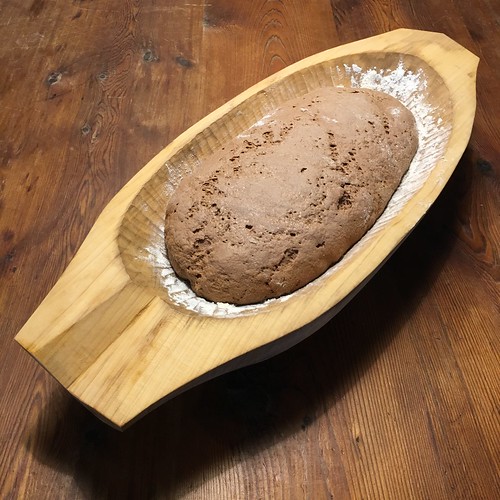- all the sourdough starter you were about to throw out
- some liquid (filtered water, milk, whey from cheesemaking, cold coffee or tea, a stale beer, whatever), maybe 1/2 to 3/4 of a cup
- 2 tsp salt
- some molasses (2 tbsp?)
- 2 heaping tablespoons cocoa powder
- optional caraway seeds (if you don't care if your kids spit the bread out of their mouths and regard you with a deep and lasting sense of betrayal)
- some sort of fat (olive oil, melted butter, coconut oil, lard, tallow, schmaltz, used motor oil, whichever you grab first), maybe 2 tbsp
- some rye flour (I don't know how much, just "enough" whatever that is).
- some whole wheat flour (seriously I don't know)
- white flour on hand for kneading
- a small handful of cornmeal, grits, or semolina for the stone (whatever is around)
- large bowl for mixing and initial proofing
- wooden spoon
- a large banneton or other vessel designed to shape and structure the loaf while proofing (this dough is more dense than my usual sourdough pain de campaign, but doesn't mind the help)
- large baking stone
- clean kitchen towel
- bread lame or sharp knife
1. Dump all of the random liquid, molasses, cocoa powder, salt, and random fat into a bowl and mix.
2. Dump in the starter you are salvaging.
3. Begin adding flour; maybe a full cup of rye to begin with then whole wheat to round things out. The goal here is to get things to form a ball that holds together, but still becomes tacky on the surfaced when worked for more than a few seconds. Once it forms a good ball I switch to sprinkling white flour, just enough to keep the surface dry enough to work.
4. Knead for a few minutes, just to make sure things are well mixed. Kneading will not help this bread tremendously. There is too little protein in the dough to form many gluten chains, and the abundance of bran particles will probably just cut them anyhow.
5. Flour or oil the mixing bowl, and allow to sit covered with a damp cloth for 2 or 3 hours.
6. Shape into a loaf and transfer to final proofing vessel. At this point you can retard in fridge out of convenience, but it is not necessary.
7. Once nearly doubled in size (about 3-4 more hours) from shaped loaf, bake (slashing the top) on a preheated stone for 10 minutes at 500 ºF (260 ºC) with steam for a crisp crust, followed by 25-30 minutes at 350 ºF (177 ºC). Bread should sound hollow when thumped on bottom. It will be dense, but pleasantly spongey and chewy (the crumbs practically bounce), good for kids who complain that their honey falls through the holes in the "other" bread.


No comments:
Post a Comment